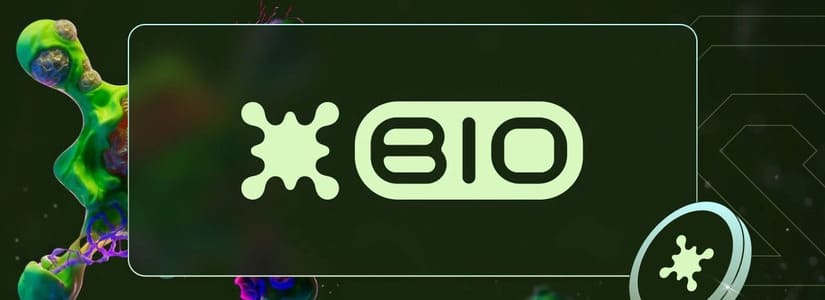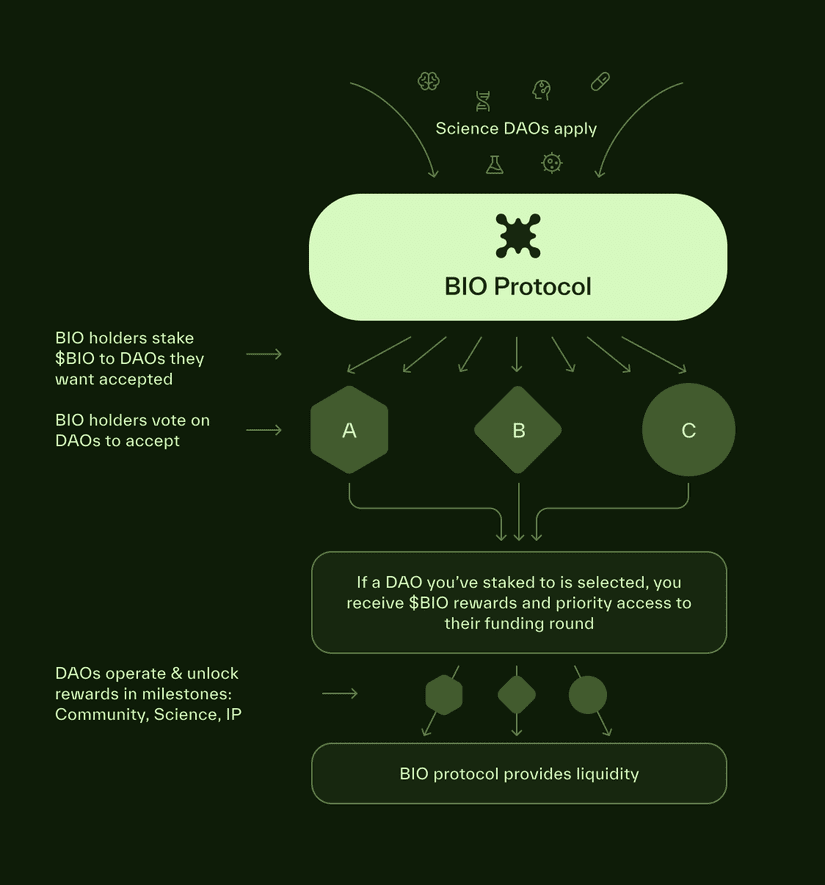The evolution of scientific research is at a turning point due to the emergence of decentralized models aiming to transform traditional methods of funding and development.
BIO Protocol is a revolutionary initiative designed to empower patients, scientists, and professionals in the field to finance, develop, and own tokenized scientific projects through community participation. This review will explore its foundations, structure, and disruptive potential in taking decentralized science to the next level.

What is Bio Protocol?
BIO Protocol is a decentralized ecosystem that serves as the backbone of a new way of conceiving research in biotechnology. Its primary objective is to accelerate scientific progress through governance and funding mechanisms based on blockchain technology.
Inspired by the decentralized science (DeSci) paradigm, this protocol enables various communities—comprising patients, scientists, and biotechnology experts—to collaborate directly in the financing and development of innovative projects. Unlike traditional methods, where investment and decision-making are concentrated in a few key players, BIO Protocol proposes a distributed and participatory model that redefines the rules of the game in the scientific field.
BIO Protocol aims to create a “bioconomy,” an ecosystem where innovation and biotechnological development are driven through open collaboration and shared ownership. In this new paradigm, the limitations of traditional scientific research—such as high costs, slow funding processes, and restricted access to intellectual property—are addressed through decentralization mechanisms.
Thus, the protocol has a dual mission: first, to democratize access to resources and capital for high-impact scientific projects; and second, to establish a framework in which decision-making and technological development are governed by the active participation of a global community.
Technical Infrastructure and Scientific Collaboration
The technical robustness of BIO Protocol is one of the pillars of its value proposition. The ecosystem is built on a modular smart contract infrastructure that enables the execution of various functions, from token distribution and airdrop management to implementing complex vesting mechanisms.
This architecture not only facilitates automation and transparency in transactions but also ensures that the platform can adapt and update in response to technological advancements and market changes. The platform places a strong emphasis on security, incorporating strict access controls and validation processes to minimize vulnerabilities.
BIO Protocol promotes open collaboration among researchers, enabling the secure exchange of data and joint work on high-impact projects. This collaborative philosophy enhances the scientific process and fosters a network of stakeholders working synergistically to accelerate the development of scientific projects.

What are BioDAOs?
At the core of Bio Protocol are BioDAOs—decentralized autonomous organizations specialized in specific areas of scientific research. Each BioDAO operates independently, focusing on fields such as genetic editing, longevity research, brain health, or synthetic biology, among others.
This structure allows the ecosystem to diversify and adapt to the particular needs of each discipline. BioDAOs facilitate the tokenization of intellectual property, transforming scientific assets into digital assets that can be fractionalized. This way, researchers and investors can share both the risks and the rewards of projects, creating new opportunities for research, development, and commercialization of scientific discoveries.
How Does BIO Protocol Work?
BIO Protocol operates as a decentralized curation and funding system designed to enhance the development of scientific projects. Within its ecosystem, participants can use their BIO tokens to vote and determine which projects and BioDAOs should receive support.
The curation process relies on a staking mechanism that involves locked versions of the token, known as vBIO. By staking BIO in the system, users can endorse initiatives they consider promising. This model incentivizes rigorous evaluation, as those participating in the curation process have an economic stake in selecting only the most scientifically and commercially viable projects.
Once a project is approved, it can access funding through various mechanisms, including private auctions, early-stage investment rounds, and direct contributions from the community. This approach not only decentralizes decision-making but also ensures that resource allocation aligns with the collective interest of participants. Furthermore, the interconnection between curation and funding establishes a direct relationship between a project’s success and community engagement.

The BIO Token: What is it and What is it For?
The BIO token is the central component of BIO Protocol, functioning as both a utility and governance asset within the ecosystem. Its primary purpose is to enable user participation in decision-making, project funding, and interaction with the various BioDAOs that form the platform.
From a functional perspective, BIO allows holders to vote on which projects and BioDAOs should be admitted to the protocol. To do this, users stake their tokens in the form of vBIO, which grants them governance rights and incentivizes them to select initiatives with high impact potential.
The BIO token also facilitates access to early-stage investment rounds in various projects, allowing users to financially support research and development within the ecosystem. This mechanism is designed to democratize funding in the sector, channeling resources toward promising initiatives without the intermediation of centralized entities.
In terms of utility, BIO not only serves as a medium for capital allocation but also acts as an incentive for participation within the platform. The ecosystem structure rewards those who contribute to project development through the use of the token, aligning community interests with the evolution of decentralized science.

Investment Perspective on Bio Protocol
Bio Protocol presents an intriguing and disruptive value proposition. The ability to combine blockchain technology with decentralized funding creates a completely new landscape for scientific research.
The BIO token is a key element for those who wish to actively participate in a revolution in scientific research. Investing in Bio Protocol means supporting a business model that not only has the potential to transform how science is funded but also offers substantial benefits to those who believe in its vision and engage in decision-making.
However, as with any investment in emerging sectors, there are inherent risks related to innovation and regulatory uncertainty. The pioneering nature of decentralized science, combined with the complexity of integrating advanced technologies into the scientific field, means that investing in Bio Protocol requires careful analysis and a long-term perspective.
Security Mechanisms in BIO Protocol
Security in BIO Protocol is based on decentralization and transparency, ensuring that all decisions and transactions within the ecosystem are recorded on the blockchain. This approach minimizes the risk of manipulation and guarantees system integrity.
As previously mentioned, one of the main security mechanisms is the use of non-transferable governance tokens, which can only be obtained by locking BIO tokens. This structure makes mass acquisition attacks more difficult and protects protocol stability by preventing external influences misaligned with the ecosystem’s interests.
Additionally, the implementation of Snapshot Voting and Governance Timelock provides a high level of security. Snapshot Voting prevents alterations in the vote distribution once a proposal has been initiated, avoiding fraud or manipulation. Meanwhile, Governance Timelock introduces a waiting period before executing approved changes, giving the community enough time to assess potential vulnerabilities and react to decisions that could compromise protocol security.

Conclusion
Bio Protocol is an ambitious and transformative initiative in the scientific field. Its proposal to decentralize scientific funding and development through participatory governance mechanisms represents a significant departure from traditional models.
The ecosystem’s structure, built around the creation and management of BioDAOs, enables projects in various scientific disciplines to receive the necessary support for conducting high-impact research. Investing in this protocol goes beyond simply acquiring assets—it involves an active commitment to the future of decentralized science.
While there are inherent challenges in any pioneering initiative, the protocol’s technical robustness, governance transparency, and focus on scientific collaboration position Bio Protocol as an interesting option for those looking to invest in the transformation of scientific funding.
The integration of blockchain technology into biotechnological research not only opens new doors for innovation but also democratizes access to resources and knowledge, allowing a broader range of participants to contribute to the development of solutions with profound societal impact












